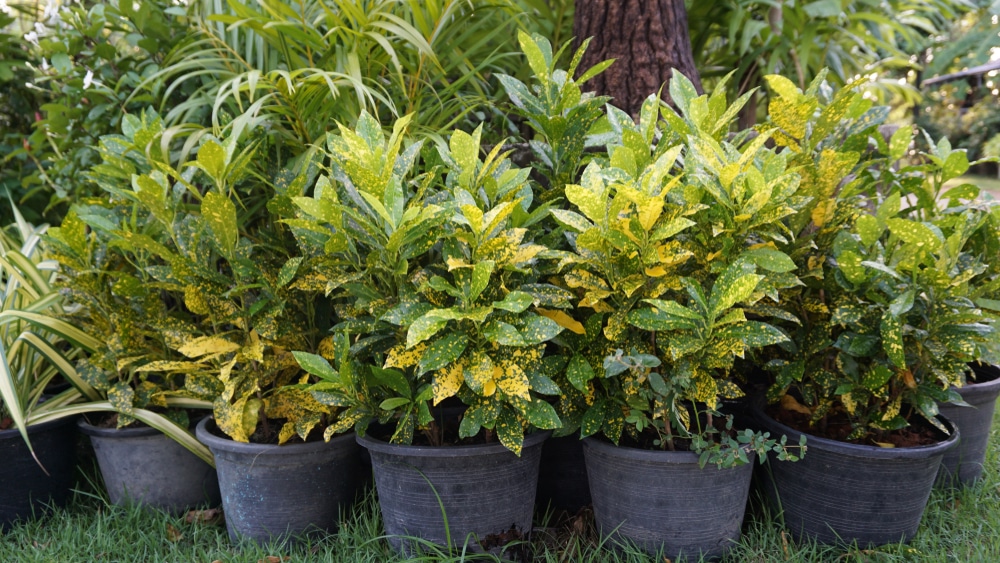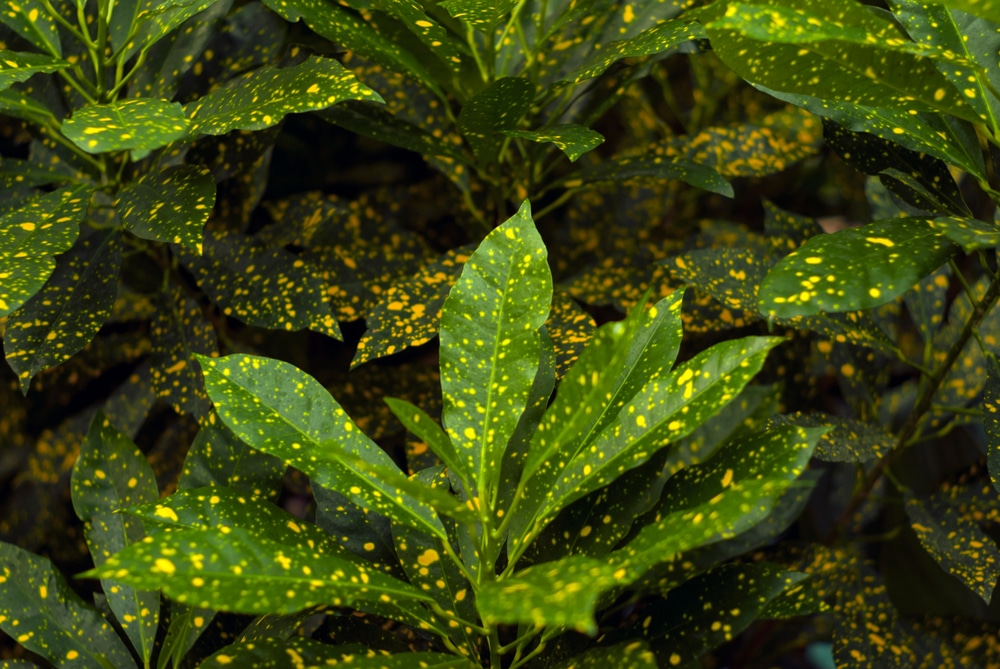Do you like houseplants? Then you’ll love growing a Gold Dust Croton: with its bold, lush, and variegated foliage, this tropical plant will add an elegant touch to any location.
Despite having a reputation for being a picky plant, growing one at home isn’t impossible. Yes, it will require some work from your side, but it will be worth it! And if you want to learn more about Gold Dust Croton, keep reading: we included everything you must know about it in this essential guide!
| Botanical Name | Codiaeum variegatum |
| Common Name | Gold Dust Croton |
| Plant Type | Perennial |
| Flower Color | Under ideal conditions, a croton might display tiny white and yellow flowers that the foliage will most likely hide. |
| Size When Mature | Up to three feet tall |
| Bloom Time | Year-round, but it rarely occurs indoors |
| Sun Requirements | Bright, indirect light |
| USDA Hardiness Zones | 11-12 |
| Soil PH Range | 4.5 to 6.5 |
| Soil Type | Well-draining, acidic, and fertile |
| Water Needs | Medium |
| Native Area | South East Asia and Western Pacific Islands |
What you Need to Know About Gold Dust Croton
A gold dust croton’s showy foliage is its most attractive feature. Its bright green with gorgeous golden spots makes the plant even more unique. To have a thriving plant, you must learn how to replicate a sub-tropical environment in your home. And while that isn’t anything out of this world, it might take some time.
Also, you should know that a gold dust croton’s sap can be toxic when ingested and cause skin irritation. So, avoid allowing your curious children or pets to munch on this plant’s leaves.
Despite reaching up to 10 feet in nature, a Gold Dust Croton won’t grow taller than 2 to 3 feet as a houseplant. Still, its compact looks won’t undermine its beauty!
How to Care for Gold Dust Croton
As we mentioned, growing a thriving gold dust croton might require some attention from your side. But don’t despair: follow the tips we included in the following sections, and you shouldn’t have issues with the task!
Light
Providing your croton with proper lighting is crucial for its growth. The plant will do best in a bright spot to receive plenty of indirect light (ideally between 4 and 6 hours daily). Without that, a gold dust croton might grow leggy and not show its attractive variegation. But be careful of direct sunlight: it may scorch your houseplant’s leaves. Don’t forget to rotate your plant’s pot to ensure an even growth pattern.
Avoid moving your plant around: crotons are susceptible to transplant shock and will lose their leaves if you expose them to new conditions.
Water and Soil Needs
You’ll need to follow a consistent watering schedule when growing a Gold Dust Croton. These plants are susceptible to overwatering but require deep moisture. To prevent issues, allow the soil to dry before adding extra water. Feel the substrate with your fingers to understand the plant’s needs.
Plant your Gold Dust in a well-draining mix. If the soil is too compact, loosen it with gravel or sand. Also, consider amending the mixture to make it slightly acidic. The ideal pH levels are between 4.5 and 7.0!
Temperature Requirements
Gold Dust Crotons are native to South East Asia. So, they thrive in warm and humid environments. You can grow them outdoors in USDA hardiness zones between 11 and 12. But if you don’t like those areas, don’t worry! This variety is an excellent houseplant!
Keep the temperature between 60 and 80°F and protect your plants from hot or cold drafts. For this reason, consider placing it at a distance from your window. Keep the humidity at about 40 to 60%. Don’t forget to mist your plant’s leaves every couple of days or add a pebble tray.
Fertilizer
To enhance your plant’s growth, you can add some fertilizer during the growing season (between the spring and the summer). Use a liquid, slow-release fertilizer for best results, and don’t forget to suspend the application in the winter.
Common Diseases
The most common problems you’ll face when growing a Gold Dust Croton result from overwatering. After all, these plants are highly susceptible to root rot and will struggle if you don’t get their watering schedule straight. Following our tips will help.
Because of their love for humidity, crotons are also a favorite among spider mites, mealy bugs, and scale insects. Keep an eye on your plant and take proper measures as soon as you notice pests to minimize damage!
Related Article: Variegated Houseplants


